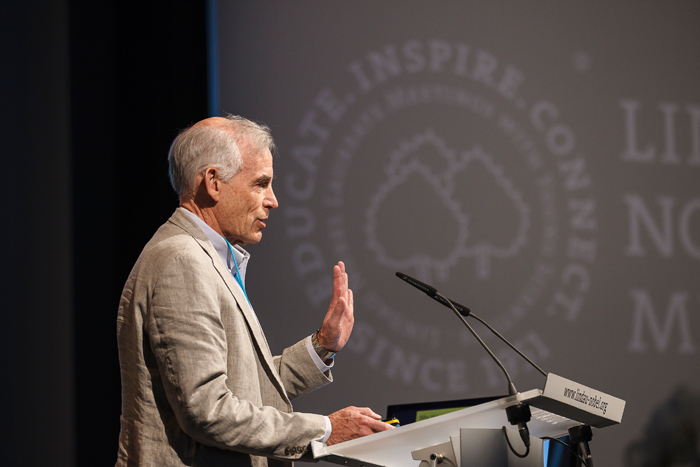Veröffentlicht 3. September 2014 von Frances Coppola
Christopher Sims: Fiscal Pessimism
In my previous post about Christopher Sims’s lecture at Lindau, I concentrated on his remarks about the increasing “moneyness” of financial assets. When both conventional “money” and other financial assets are highly liquid and fungible, monetary and fiscal policy become indistinguishable. What does that imply for price stability and the role of central banks?
The traditional quantity theory of money MV=PY proposes that (assuming velocity V is constant) increasing the quantity of M (defined as the monetary base M0) in circulation will result in an increase in the price level P unless production Y also increases. The lack of a time dimension in this equation makes it difficult to square with the „long and variable“ lags that are characteristic of monetary policy actions: neither the price level P nor production Y respond instantaneously to increasing M. And in a world in which there are many forms of money, most of which are not represented in M, the equation is incomplete anyway. For Sims, the final nail in the coffin of MV=PY is the presence of excess reserves in the banking system, which means that the conventional “money multiplier” no longer applies. Of course those of us who are endogenous money fans will argue that the money multiplier never did apply ex ante, only ex post: but Sims approached this from a mainstream economics perspective. “The money multiplier is dead”, he said.

Empirically, it is abundantly clear that there is no clear relationship between the quantity of monetary base and the price level. If there were, then we would now have rampant inflation. Indeed when central banks started to do QE after the financial crisis, many people forecast runaway inflation and even hyperinflation as a result of what was wrongly called “money printing”. But six years later, central bank balance sheets have never been so large, but inflation in developed countries is below target and in many cases falling. So it seems that Sims’s diagnosis is indeed correct. MV=PY (with M defined as the monetary base) is no longer fit for purpose.
But if there is no longer any clear relationship between the quantity of monetary base M0 in the system and the price level, central banks need some other means of forecasting the price level. Sims therefore presents the Fiscal Theory of the Price Level (FTPL).
FTPL essentially says that inflation is a function of the yield on government debt. Sims presents this in algebra of course, but I shall attempt to explain it in words.

The market acceptance of government debt depends on the credibility of government commitment to future primary surpluses to ensure the debt can always be serviced. If that commitment is in doubt, investors reject the debt and yields rise. If the sovereign concerned is a currency issuer with its own central bank, the presumption is that debt would be monetised at some point in the future, causing inflation expectations to rise and the exchange rate to fall. Note that this means that, for currency issuers, there is a direct relationship between the market value of government debt, the market value of the currency and the purchasing power of the currency. (This is not, of course, true of countries in the Eurozone, which do not issue their own currencies. In the lecture Sims concluded that to survive, the Eurozone really does have to go for full fiscal union and both monetary and fiscal expansion.)
If the central bank attempts to counter this inflation by raising interest rates, the sovereign’s debt servicing ability becomes even less credible, making the situation worse. Interest rate rises when the sovereign’s ability to service its debts is in doubt are inflationary. This is pretty orthodox stuff.
But in the present situation – what Sims calls “fiscal pessimism” – FTPL predicts disinflation. Fiscal pessimism means that people look with horror at rising government debt burdens and future fiscal commitments such as those arising from an ageing population, and think “how on earth are we going to afford this”? They expect much higher taxes in the future and/or serious cuts to spending programmes. If this is also combined with very low interest rates, so they make little or nothing on their growing holdings of government debt, they feel poorer even though their nominal wealth is actually increasing. They may therefore cut discretionary spending and increase precautionary saving in compensation, causing a disinflationary trend. As Sims put it:
“If we combine monetary policy that fixes interest rates near zero for an extended period of time with fiscal policy that makes people feel less wealthy as their holdings of government debt rise, the fiscal theory of the price level predicts that inflation will become indeterminate and drift downwards”
Exactly as we are seeing, in fact. And the problem is not just that inflation drifts downwards – growth does too due to failure of aggregate demand. Cutting discretionary spending and increasing saving is rational behaviour for the fiscally pessimistic, but it is economically destructive. For growth to resume and fiscal burdens to be reduced, the pessimistic have to be induced to spend.

Sims says that for countries suffering from fiscal pessimism, the first priority must be to restore growth, firstly to prevent debt/gdp from increasing despite primary surpluses, and secondly to give people the hope that future obligations can be met without crippling taxes and/or reneging on commitments such as state pensions. Monetary policy cannot by itself create growth: what is required is fiscal expansion. Governments should take advantage of low interest rates to lock in low debt service costs for the future, and should embark on a programme of balanced-budget and/or high-multiplier fiscal investments to kickstart growth. A credible plan should then be established to bring down debt/gdp gradually over the medium term. (This all sounds very familiar to a British ear. Former Chancellor of the Exchequer Alistair Darling must be tempted to shout “I told you so”).
Sims argues that such an approach would have far more chance of working, and therefore be far more credible, than front-loaded austerity to bring down debt/gdp fast. And credibility is key. Inflation can remain under control even with high debt/gdp if the government’s fiscal stance is credible.
And at this point I depart from Sims’s lecture. It is all very well observing that hope seems to have departed and people appear to have resigned themselves to a depressing, and depressed, future. But why are people so pessimistic? What – or who – has convinced people that government debt levels are unsustainable and there is significant pain to come? In a word, economists.
For the last thirty years, the economics profession as a whole has sung the praises of monetary policy run by independent central banks and denigrated or sidelined fiscal policy run by elected governments. Economic researchers have “proved” the following:
- runaway inflation is inevitable unless fiscal authorities are forced to operate within a monetary policy envelope set by the central bank (“monetary dominance”)
- short-term fiscal expansion is pointless because people will simply increase precautionary saving in expectation of higher taxes in the future (Barro-Ricardian equivalence)
- the state competes with the private sector for funding, so if it gets too large it absorbs funding needed by the private sector, preventing it from growing (“crowding out” theory)
- fiscal austerity can result in growth (“expansionary fiscal contraction”)
- if debt/gdp rises above 90% growth will come to a shuddering halt (Reinhart & Rogoff)
- both inflation and growth can be generated by the central bank without involving fiscal authorities (market monetarism)
Not one of these has been proven empirically. Some have even been shown NOT to be true, and others are failing to live up to the predictions of theory. But the beliefs live on. Sims’s theory of “fiscal pessimism” assumes that Barro-Ricardian equivalence applies in people’s minds, even if not in reality. And in her speech at the Lindau opening ceremony, Chancellor Merkel of Germany made the following remark:
“The German experience shows that fiscal consolidation and growth are not incompatible.”
And she went on to suggest that there should be tougher sanctions for countries that broke the Maastricht treaty requirements of a deficit of no more than 3% of GDP and debt/gdp no higher than 60%. In a press briefing later that day Sims, apparently horrified by this, reinterpreted “sanctions” as “punishment”:
“I can’t see that punishing countries for breaking the debt rules is helpful”, he said.
The economic beliefs that underlie financial pessimism have become deeply entrenched. However, it is encouraging to hear a world-renowned economist advocating fiscal expansion to restore growth. And he was not the only Nobel laureate at Lindau promoting a greater role for fiscal policy in the quest for recovery: others included Peter Diamond and Eric Maskin. Let’s hope this new recognition of the vital importance of fiscal policy and the damaging effects of arbitrary fiscal constraints feeds through into real changes in economic policy-making.
Related reading:
Inflation is always and everywhere a political phenomenon
QE is fiscal policy– Coppola Comment
Nobel-winning economists challenge conventional thinking on recovery– Philip Inman, The Guardian